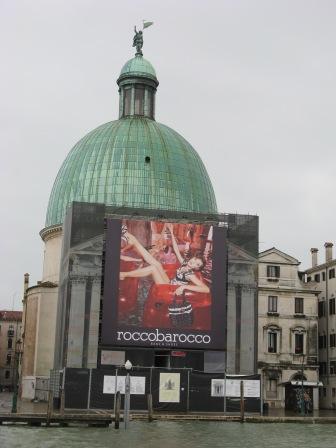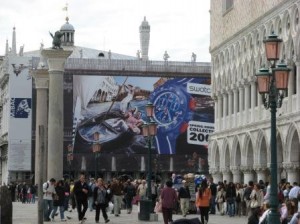When you walk out of the train station in Venice, the Grand Canal is the first thing you see. Or ought to see. I remember that day 25 years ago; it was a bolt from the blue from which I have never recovered.
But the Grand Canal hasn’t been the first thing you see for quite a while now. Your eye goes straight to the imposing baroque church on the other side of the water, and you’ll be staring at it not because it’s a church, or baroque, or imposing. It will be because of the imposing not-even-close-to-baroque billboard covering the facade. I won’t describe it, I’ll just show it to you:
The idea of offering a sponsor a public space to promote its product in exchange for the money needed for restoration of art and architecture has become the greatest thing to hit Venice since the invention of the coffeehouse. And it is absolutely true that the billboard preceding this one was much worse, as the lady promoting a line of handbags was even less clad. This is the kind of hair-splitting you find yourself indulging in here, but “It could always be worse” doesn’t get it done in a city that is an entire work of art.
Since the city never has any money to do anything it doesn’t feel like doing (though there are weekly miracles in which funds appear for all sorts of unexpectedly necessary things, like installing turnstiles on the vaporetto docks), for some time now it has been offering vast spaces for private cash on monuments. I am not the only person who finds this ad objectionable (nor am I the only person who is wondering why this church has been condemned to Restoration Purgatory; it’s been under scaffolding since the first time I saw it, in 1985). Plenty of people have objected.
I also find it objectionable that half of the Doge’s Palace is covered with publicity for Chopard (it started last September, with ads for Lancia), and  most of the Marciana Library is concealed by silliness by Swatch. By the way, there is a national law which requires that the scaffolding covering a public monument under restoration must show a perfect replica of the concealed facade. A mere detail, obviously. But I’m getting ahead of myself.
most of the Marciana Library is concealed by silliness by Swatch. By the way, there is a national law which requires that the scaffolding covering a public monument under restoration must show a perfect replica of the concealed facade. A mere detail, obviously. But I’m getting ahead of myself.
And I mustn’t let myself stop now to talk about how the city had stamped all the waivers needed to allow a Maltese business to put five mothers-of-all-Jumbotrons in the Piazza San Marco, a UNESCO World Heritage Site, in exchange for millions of euros to restore the buildings they would be defacing. This plan seems to have been halted, at least for now. One can never be sure if these shenanigans are really dead, or just in hibernation.
Don’t imagine that there are no rules for the safeguarding of Venice’s monuments. There are metric tons of them. But here is how the Doge’s Palace became, overnight, the most beautiful billboard in the world:
The palace needed restoration; among other things, bits of marble were falling off it and barely missing passing tourists. The work would cost 2 million euros, which the city doesn’t have. So the Dottor Group, a massive company specializing in architectural and historic restoration, got the job and put up the money, and so they get to rent out the billboard space of the gods. Then they installed the scaffolding (of course there are also laws limiting the square-footage allowed for publicity on public monuments, which these exceed) by driving iron hooks between the 500-year-old blocks of Istrian stone, hooks which will be there for at least three years.
Suddenly the legs-on-the-church don’t look quite so bad? That’s how you begin to lose your bearings here. But never mind your taste in legs, or churches. There are so many other facets to the plight of San Simeon Piccolo that I can’t organize them for you; I’ll just give them as they come to me.
- Nobody knows how much money is needed for the restoration
- Nobody can say how much money has been found so far for the restoration
- Nobody knows how many hours a day that SACAIM, the restoration company, is working at the site, or whether the contract is being honored
- SACAIM won’t make any statement on whether or not the work has been stopped because it hasn’t been paid all the money it’s due
- Nobody knows what criteria are involved in deciding what is considered acceptable publicity
- The Curia (the church administration) has stated many times that seeking pelf through publicity is “squalid” (there goes most of Western civilization). But this point is especially tricky because church buildings aren’t technically the responsibility of the Church in Italy anymore, but are wards of the state and depend on federal money which is allocated by an assortment of Superintendencies (for architecture, archaeology, “cultural goods,” and so on).
- The Municipal Police (as with the Superintendencies, there is a variety of forces of public order, with varying responsibilities) says that it has done its job as far as paperwork is concerned, the array of official permissions required for work on public buildings, or on public spaces. So technically it has no authority to remove the poster.
The Superintendency of Architectonic Treasures has already stated (as with the handbag-lady poster) that the publicity has to come down. The Curia is against it, but the Superintendency says that the Curia has the power of reviewing all publicity before it goes up. But wait — in the controversy of the Jumbotrons, the Superintendent herself, Renata Codello, stated that every piece of publicity put up during restoration work is regularly approved or rejected by the Superintendency. So who gave the permission for this poster to be put up in the first place? Nobody knows.
So here we are: Nobody decided to put it up, and now nobody can decide whether or how to get it down. But this sudden flurry of discussion is making the Superintendent a little testy.
Yesterday Monsignor Antonio Meneguolo pushed his advantage a little too far by stating that this whole thing is “monstrous and immoral.” Superintendent Codello shot back that even though she never gave permission for this poster (that ought to be an embarrassing thing for a superintendent to admit, but let’s keep going), the Curia hasn’t got much to be proud of either. “We’re all for publicity,” she told the Gazzettino, “it’s the only way which allows us to be able to restore buildings. If the Curia were to put up some money, we’d take the publicity down.”
Furthermore, “It’s not as if we could have just left the church to fall to pieces, abandoned by the Curia. The patriarchate has never put up a single euro.” So there.
But what about how hideous it is? She’s ready: “The churches of the city are full of examples of really bad interventions.” Presumably not approved by the superintendent. Though one doesn’t know why.
This bickering only shows that here in the Cradle of the Renaissance people still defend themselves by saying “Yes, I did it, but he did worse.” Which comes right after you say “Well he started it.”
Let’s imagine that I understand most of what has been going on. What I really don’t understand is why this horrible thing has become an issue right now. It was out there for months and months and nobody said anything. Now, all of a sudden, it’s a huge problem.
In fact, the only thing that both the Superintendent and the Monsignor agree on is that they are shocked, shocked to find that there is a vulgar and immoral billboard on a church.
(I acknowledge the excellent reporting of Davide Scalzotto).




2 Comments
Did they do anything about this? Did they remove the billboard?
They removed that particular ad but the billboard is still there, hard at work making money for somebody.